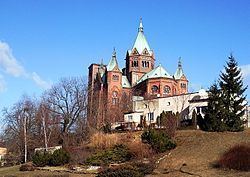Country Poland Time zone CET (UTC+1) Population 34,071 (2008) | Gmina Czeladź (urban gmina) Area 16.38 km² Local time Tuesday 8:46 PM | |
 | ||
Postal code 41-250, 41-253 (Piaski suburb) Weather 5°C, Wind W at 6 km/h, 79% Humidity Points of interest Muzeum Saturn w Czeladzi, Park Grabek, Plac Zabaw | ||
Czeladź [ˈt͡ʂɛlat͡ɕ] is a town in Zagłębie Dąbrowskie (part of historic Lesser Poland), in southern Poland, near Katowice and Sosnowiec. Located in the Silesian Highlands, on the Brynica river (tributary of the Vistula), it is the oldest urban center of Zagłębie Dąbrowskie. The area of Czeladź is 16 km2., and it borders Będzin, Sosnowiec, Katowice and Siemianowice Śląskie.
Contents
Map of Czeladz, Poland
The town is situated in the Silesian Voivodeship since its formation in 1999, previously it was in Katowice Voivodeship. Czeladź is one of the cities of the 2,7 million conurbation – Katowice urban area and within a greater Silesian metropolitan area populated by about 5,294,000 people. The population of the town is 34,072 (2008). Founded in the 13th century, Czeladź was granted city status in 1262. In the years 1434–1790, it belonged to the Duchy of Siewierz. In the 19th century, Czeladź became an important mining center, with the Saturn coal mine opened there in the late 19th century. It also was a main center of Jewish culture, destroyed in The Holocaust.
History
First historic mention of Czeladź comes from 1228, in a bill of Prince Kazimierz of Opole, in which the boundaries of the village were mentioned, a public house, as well as a bridge over the Brynica. In 1243, the village (spelled as Celad, and already having the status of a defensive gord) was mentioned again, this time in a document of Prince Konrad Mazowiecki, as it had been destroyed in 1241, during the Mongol invasion of Poland. It belonged to an abbey from Staniątki, and in 1260, Prince Władysław of Opole decided to purchase the village with its parish church. Two years later, Czeladź was sold to an abbey from Henryków, and was granted Magdeburg rights. The town remained within territory of Silesian duchies, but at the same time, Czeles, as it was known, was under the jurisdiction of bishops of Kraków. In 1434 it became part of the Duchy of Siewierz, a property of Kraków Bishops. The town had a defensive wall, remains of which were discovered in 2006, and a town hall, where on March 9, 1589, the agreement between Poles and Austrians was signed, ending the War of the Polish Succession. Even though the Duchy of Siewierz was not officially part of the Polish–Lithuanian Commonwealth, Czeladź was destroyed by the Swedes in the Deluge (1655–60).
In 1790, the Duchy of Siewierz was incorporated into the Commonwealth, and King Stanisław August Poniatowski made Czeladź a free city. After the Partitions of Poland, Czeladź since 1815 belonged to the Russian-controlled Congress Poland, and was located on the border with Kingdom of Prussia's province of Silesia. Since the 1860s, the town began to turn into an industrial center. Two coal mines were opened – Czeladź (1870), and Saturn (1880). Workers' settlements were built, and the dynamic growth was not stopped by World War I, when Czeladź was occupied by the German Empire. In 1915, a power plant was opened, and Czeladź became a magnet for farmers from overpopulated central Lesser Poland's villages, who came here in search of work. Tenement houses replaced wooden huts, streets were paved and parks opened. Mining emerged as an engine of town's development, and in the Polish People's Republic, Czeladź kept its industrial position. Coal resources, however, became depleted and mines, starting in the 1960s, would make their workers redundant. Since the notion of unemployment did not officially exist in a Communist country, new companies were opened for the dismissed miners – Transport Company Transbud (1969), Energy Company Energopol (1970), and Window Manufacturer Erg (1971).
In the mid-1970s, a number of blocks of flats was built in Czeladź, to accommodate an influx of workers employed at the construction of Katowice Steelworks. Communist planners estimated that by the year 2000, the population of Czeladź would grow to reach 100,000, but the collapse of the system in the 1980s changed these estimates.
Among points of interest there are:
Notable residents
Twin towns — Sister cities
Czeladź is twinned with:
